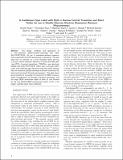A gadolinium spin label with both a narrow central transition and short tether for use in double electron electron resonance distance measurements
View/
Date
18/02/2019Author
Grant ID
EP/R013705/1
099149/Z/12/Z
UF150698
Metadata
Show full item recordAbstract
The design, synthesis, and application of a nine-coordinate gadolinium(III)-containing spin label, [Gd.sTPATCN]-SL, for use in nanometer-distance measurement experiments by EPR spectroscopy is presented. The spin label links to cysteines via a short thioether tether and has a narrow central transition indicative of small zero-field splitting (ZFS). A protein homodimer, TRIM25cc, was selectively labeled with [Gd.sTPATCN]-SL (70%) and a nitroxide (30%) under mild conditions and measured using the double electron electron resonance (DEER) technique with both commercial Q-band and home-built W-band spectrometers. The label shows great promise for increasing the sensitivity of DEER measurements through both its favorable relaxation parameters and the large DEER modulation depth at both Q- and W-band for the inter-Gd(III) DEER measurement which, at 9%, is the largest recorded under these conditions.
Citation
Shah , A , Roux , A , Starck , M , Mosely , J A , Stevens , M , Norman , D G , Hunter , R I , El Mkami , H , Smith , G , Parker , D & Lovett , J E 2019 , ' A gadolinium spin label with both a narrow central transition and short tether for use in double electron electron resonance distance measurements ' , Inorganic Chemistry , vol. Article ASAP . https://doi.org/10.1021/acs.inorgchem.8b02892
Publication
Inorganic Chemistry
Status
Peer reviewed
ISSN
0020-1669Type
Journal article
Description
Funding from ERC (266804), EPSRC (EP/R013705/1, EP/M508214/1), Carnegie Trust (RIG007510), Wellcome Trust for a Multi-User Equipment Grant (099149/Z/12/Z), and the Royal Society for a University Research Fellowship to JEL.Collections
Items in the St Andrews Research Repository are protected by copyright, with all rights reserved, unless otherwise indicated.

